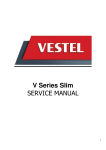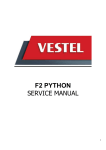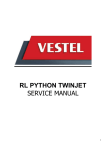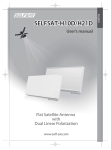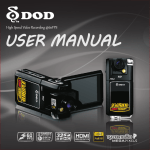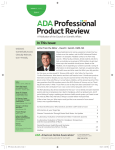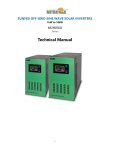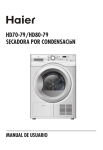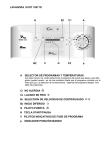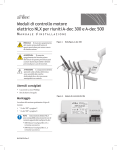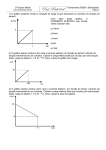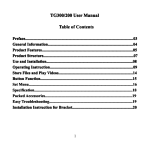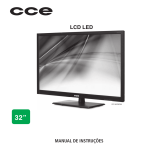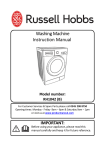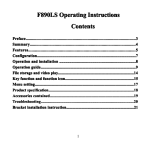Download V Series Slim SERVICE MANUAL
Transcript
V Series Slim SERVICE MANUAL 1 TABLE OF CONTENTS 1. Specifications 1.1. Product Specifications 1.2. Name Plate 2. Installation Instructions 2.1. Moving and Installing 2.2. Detergent Box Group 3. Operating Instructions 5.1. LCD Screen, Function Buttons & Knobs 5.2. Program List 5.3. Program Details 5.5. Child Lock 4. Test Mode 6.1. Autotest 5. Service Mode 5.1. Service Autotest 5.2. Failure Codes 6. Troubleshooting Guide 7. Disassembly and Assembly Instructions 7.1. Top Plate 7.2. Door 7.3. Tub Bellows Seal 7.4. Detergent Drawer 7.5. Control Panel 7.6. Kick Plate 7.7. Front Panel 7.8. Upper Support Bracket 7.9. Detergent Drawer Housing 7.10. Power Cable Group and Parazit Filter 7.11. Electronic Pressure Switch (EPS) 7.12. Door Lock 7.13. Pump Motor 7.14. Front Counterweight 7.15. Heater 7.16. Tub Bellows Seal 7.17. Transport Screw 7.18. Upper Counterweight 7.19. Washing Group 7.20. Shock Absorber PIN 7.21. Belt 7.22. Driven Pulley 7.23. Motor 7.24. Tub Entrance with Bellow Hose 7.25. Pressure Switch Hose Group 7.26. Tub 7.27. Drum 8. Component Specifications 8.1. Drain Pump 8.3. Resistance 8.4. NTC 8.5. Valve 8.6. Electronic Pressure Switch (EPS) 8.7. Motor 8.8. Door Lock 9. Wiring Diagram 9.1. Wiring Diagram NA-127VB3 and NA-147VB3 PAGE 3 3 3 4 4 5 6 6 6 7 8 9 9 11 11 12 12 14 14 14 16 16 16 18 18 20 20 21 22 22 22 23 23 24 24 25 25 26 26 26 26 27 27 27 27 28 28 30 32 34 36 37 40 42 42 2 1. 1.1. Specifications Product Specifications 40 lt Product Type Front Loader Capacity 5 kg Max Spin Speed (r/min) 400 – 500 – 600 – 800 – 1000 – 1200 - 1400 Energy Consumption A Water Consumption 43 L/cycle Control Panel LED display Wash Programs 15 settings Dimensions Height 84,5 cm Width 59,7 cm Depth 41,6 cm Child Lock Other Features 1.2. Delay Time Name Plate 0000 SERVICE INDEX NUMBER 3 2. Installation Instructions 2.1. 2.1.1. 1. 2. 3. 2.1.2. 1. 2. 3. 4. 2.1.3. 1. 2. Moving and Installing Removal of Transportation Screw Transportation screws, which are located at the back side of the machine, must be removed before running the machine. Loosen the screws by turning them anticlockwise with a suitable spanner. Pull out the screws and rubber washers. 4. The holes where the transport screws have been removed should be covered with the plastic transport caps found in the accessories bag. 5. The transportation screws that have been removed from the machine must be re-used in any future transporting of the machine. 5. Change the level by adjusting the feet upwards or downwards. After level has been reached, tighten the plastic adjustment nut again by rotating it upwards against the base of the cabinet. Never put cartons, wooden blocks or similar materials under the machine to balance irregularities of the floor. Foot Adjustment Do not install machine on rugs or similar surfaces. For machine to work silently and without any vibration, it should be installed on a flat, non-slippery firm surface. Any suspended floor must be suitably strengthened. You can adjust the level of machine using its feet. First, loosen the plastic adjustment nut away from the cabinet base. 6. 7. Electrical Connection Washing machine requires a 50Hz supply of 220240Volts. A special earthed plug has been attached to the supply cord of washing machine. This plug must be fitted to an earthed socket. The fuse value fitted to this plug should be 13 amps. If you have any doubts about electrical supply, consult a qualified electrician. THIS APPLIANCE MUST BE EARTHED. Insert the machine’s plug to a grounded socket which you can easily reach. 2.1.4. 1. 2. 3. 4. Water Supply Connection Washing machine is supplied with a single (cold) water inlet. To prevent leakage from the connection joints, a rubber washer is included in the hose packing. Fit this washer at the end of water inlet hose on the tap side. Connect the hose to the water inlet valve. Tighten the plastic connector by hand. Please call a qualified plumber if you are unsure about this. Water pressure of 0,1-1 MPa from tap will enable machine to work more efficiently.(0,1 MPa pressure means water flow of more than 8 litres in 1 minute from a fully opened tap) 5. 6. 7. 3. 2.1.5. 1. 2. Drain Connection Make sure that water inlet hoses are not folded, twisted, crushed or stretched. The drain hose should be mounted at a minimum height of 60 cm, and a maximum height of 100 cm from the floor. 2.2. 4. After connection is complete, check for leakage by turning on tap completely. Make sure that water inlet hoses can not become folded, damaged, stretched or crushed when the washing machine is in its final position. Mount the water inlet hose to a ¾” threaded water tap. The end of the drain hose can be connected directly to a drainage stand-pipe or alternatively to a specific connection point designed for that purpose on the waste outlet of a sink unit. Do not extend the drain hose or guarantee will be invalidated. Detergent Box Group VALVE1 MAIN SOFTENER PREWASH VALVE2 PREWASH MAIN SOFTENER = WATER ENTRY VALVE 1 = WATER ENTRY VALVE 2 = WATER ENTRY VALVE 1 + VALVE 2 5 3. 3.1. Operating Instructions LCD Screen, Function Buttons & Knobs PR PT SW2 SW1 SW3 SW4 SW5 PR SW1 SW2 SW3 SW4 SW5 PT 3.2. Program selector 16 programs with ON/OFF. Switch 1, Start / Pause Switch 2 Switch 3 Switch 4 Switch 5 PT speed potentiometer Program List Knob Position Pos1 Pos2 Pos3 Pos4 Pos5 Pos6 Pos7 Pos8 Pos9 Pos10 Pos11 Pos12 Pos13 Pos14 Pos15 Pos16 Program COTTON90°C COTTON 60°C PW COTTON 60°C DELICATE COLORS COTTON 40°C SYNTHETICS 60°C CURTAIN WASH SYNTHETICS 40°C Hand Wash MIX WASH HAND WASH 30°C SILK WOOL COLD QUICK WASH 15 °C Wash STOP 6 3.3. Program Details Program Details for 40 lt Total Water Consumption (lt) Total time (min) Max. T(°C) Max.energy(kwh) COTTON90°C 61.6lt 125min 83°C 1.02kwh COTTON 60°C PW 56,6lt 137,2min 51°C 1.02kwh COTTON 60°C 40,8lt 146min 55'c 0,87kwh DELICATE COLORS 51lt 95min 42°C 0.49kwh COTTON 40°C 52.6lt 125min 41°C 0.66kwh SYNTHETICS 60°C 30lt 85min 56°C 0.74kwh CURTAIN WASH 51.8lt 120min 41°C 0.87kwh SYNTHETICS 40°C 25,8lt 78min 43°C 0.44kwh MIX WASH 25.6lt 68min 32°C 0.28kwh WOOL 40°C 52.4lt 57min 41°C 0.40kwh HAND WASH 30°C 50.1lt 60min 32°C 0.30kwh SILK 49lt 54min 31°C 0.25kwh WOOL COLD 52lt 54min * 0.02kwh QUICK WASH 20.1lt 23min 25°C 0.14kwh * : Programme duration ,Energy and Water Consumption are given for the cycles for programmes are started in set temperature. WIT : Water Inlet Temperature - : Programmes do not take water • Temperature may vary depending on the heating time • Durations may vary according to wash load (weight and type), tap water and ambient temperature and selected extra functions. 7 3.5. Child Lock Activation 1. 2. The Chihl Lock Symbol is appear on the lcd display. 2. The Child Lock Symbol is deleted on the lcd display. Press the 1. and 2. function button for 4-5 seconds. Deactivation 1. Press the 1. and 2. function button for 4-5 seconds. Deactivation Indication Activation Indication 1. Option icon makes fast blink and is then off. 1. The symbol (I6) makes fast blink for indication and is then fix on. Child lock during the programme 1. Machine does not respond to any pressing of buttons or changing position of program knob but option icon makes fast blink to evoke the user. In end condition 1. When cycle is finished child lock is automatically deactivated. In Error Mode 1. Child lock will be automatically deactivated when error is detected except NTC (E05) and Voltage (E09) errors. When E05 and E09 is detected, the child lock will be deactivated at the end of the program or the user will be able to deactivate it. On other hand, if the user brings the programme knob to zero and then any position during these two error modes, firstly it will show child lock active indication and then the error indication and it will continue the cycle. 8 4. Test Mode 4.1. Autotest * This test is for quick checking of the product. You can not see the failure codes. 1. Press the 1st Function button when the Program knob is at the STOP position. 2. While pressing 1st Fuction button. Change the position of the knob to 1. 9 10 5. Service Mode 5.1. Failure Codes Error Indication Door is not locked Door is unlocked during programme Lack of water Pump failure Overflow NTC or Heater Failure Motor Failure - 1 (Tachometer open-short circuit or motor connector is disconnected) Motor Failure - 2 (triac short circuit) Electronic Pressure Sensor 6. E01 E01 E02 E03 E04 E05 Indication For User Yes/No Yes Yes Yes Yes Yes No Indication For Service Yes/No Yes Yes Yes Yes Yes Yes E06 No Yes E08 E10 No No Yes Yes Error Number Troubleshooting Guide All repairs which must be done on the machine should be done by authorized agents only. When a repair is required for machine or you are unable to eliminate the failure with the help of the information given below: • • Unplug the machine. Close the water tap. FAILURE Machine does not operate. Machine does not receive water. Machine is not draining water. Machine is vibrating. PROBABLE CAUSE METHODS OF ELIMINATION It is unplugged. Fuse is defective. Insert the plug into the socket. Change fuse. Start / Pause button has not been pressed. Press the start / pause button. The program knob is in 0 (off) status. Bring the program knob on the desired status. The door is not shut properly. Shut the door properly. You should hear the click. Child lock is active. Water tap is closed. The water inlet hose may be bent. The water inlet hose is obstructed. The water inlet filter is obstructed. See page 9. Open water tap. Check the water inlet hose. Clean the filters of water inlet hose. Clean the valve inlet filters. The door is not shut properly. Shut the door properly. You should hear the click. The drain hose is obstructed or bent. The pump filter is obstructed. The clothes are not placed inside the machine in a well-balanced manner. The feet of machine are not adjusted. Transportation screws are not removed. There is a small amount of clothes in the device. Excessive amount of clothes are filled in the machine or the clothes are not placed in a well-balanced manner. Check the drain hose. Clean the pump filter. Spread the clothes inside the machine in an orderly and well-balanced manner. Adjust the feet. Remove transportation screws. It does not prevent operation of the machine. Do not exceed the recommended quantity of clothes and spared clothes in the machine in a well-balanced manner. FAILURE Excessive foam in the detergent drawer PROBABLE CAUSE Too much detergent has been used. Wrong detergent has been used. The washing result is bad. The washing result is not good. Laundry too dirty for the program you have selected. The amount of detergent used is not sufficient. Clothes exceeding the maximum capacity has been filled in machine. Water may be hard. Distribution of the clothes in machine is not well-balanced. The water is seen in the drum during washing. There are residues of detergent on the clothes. There are grey stains on the clothes. METHODS OF ELIMINATION Press the start/pause button. In order to stop the foam, dilute one table-spoon of softener in half liter of water and pour it in the detergent drawer. Press the start/pause button after 5-10 minutes. Arrange the amount of the detergent properly in the next washing process. Use only the detergents produced for full automatic machines. Select a suitable program. Use more detergent according to the detergent. Put the clothes in machine in a manner not to exceed its maximum capacity. Use the amount of detergent according to the declaration of the detergent producer. Spread the clothes inside the machine in an orderly and well-balanced manner. No failure. The water is at the lower part of the drum. The pieces of some detergents which do not dissolve in water may stick to clothes as white stains. These stains may be caused by oil, cream or ointment. The spinning No failure. The unbalanced load process is not done control works in that way. or starts with delay. By calibrating machine for “Rinsing” program, make an additional rinsing or eliminate the stains After drying with the help of a brush. In the next washing operation, use the maximum detergent amount declared by the detergent producer. The unbalanced load control system will try to distribute clothes in a homogenous manner. After clothes are distributed, passage to spinning process will be realized. In the next washing process, place clothes into the machine in a well-balanced manner. 12 7. Disassembly and Assembly Instructions 7.1. Top Plate 1. Remove two screws that fix the top-plate at the back. 2. Push the top-plate back and pull it up. 2. Pull the door up. 3. Remove screws that fix the door group. 4. Put the door outside plastic with helping screwdriver as it is shown in the picture. 2 1 7.2. 1. Door Remove two screws that fix the door. (by using the T25) T25 13 5. Remove the door inside plastic as it is shown in the picture. 6. Remove six screws that fix the door hinge as it is shown in the picture. 7. Remove the door handle as it is shown in the picture. 8. Remove the door handle pim as it is shown in the picture. 14 7.3. Tub Bellows Seal 1. First remove the spring wire fixing the tub bellows seal by using the small size screw driver. Pull the tub bellows seal as it is shown in the picture. 2. Remove the tub bellows seal-body fixing spring. 7.4. 1. 7.5. 1. Detergent Drawer Remove the detergent drawer and pull it up carefully Control Panel Remove the screw which fix the control panel to the front panel. 15 2. Remove three screws fixing the control panel. 5. Remove the lcd communication cable as it is shown in the picture. 3. Pull the control panel up. 6. Remove electronic card cover as it is shown in the picture by using small screw driver. 4. Remove connectors as it is shown in the picture. 7. Remove lcd electronic card as it is shown in the picture. 16 7.6. 7.7. Kick Plate Front Panel 1. Remove the right part of the kickplate as it is shown in the picture. 1. Remove two screws fixing the front panel at the bottom as it is shown in the picture by using T25 2. Remove two screws fixing the kickplate. 2. Remove two screws fixing the door lock as it is shown in the pictures. 3. Pull the kickplate left and push it down. 2 1 17 3. Remove the tub bellows seal as it is shown in the pictures. 4. Remove two screws fixing front panel at the upper as it is shown in the picture. 5. Remove two screws fixing front panel at the below as it is shown in the picture. 6. Remove the front panel as it is shown in the pictures. 18 7.8. Upper Support Bracket 7.9. Detergent Drawer Housing 1. Remove two screws fixing the body group at the front as it is shown in the picture. 1. Remove the tub seal clamp by using the pliers, which is attached to the detergent drawer housing. 2. Remove two screws fixing the body group at the upper as it is shown in the picture. 2. Remove the four connectors that is connected to the feed valve as it is shown in the picture. 3. Remove detergent drawer group two clips fixing the upper support bracket as it is shown in the picture. 3. Turn the feed valve counter clockwise slightly to remove. 19 4. Remove the detergent drawer screw. 2. Remove two screws fixing the parasite filter. 5. Remove the detergent drawer housing assembly. 3. Pull the power cable group up as it is shown in the picture. 4. Remove parasite fitler fixing body group as it is shown in the picture. 7.10. 1. Power Cable Group and Parazit Filter Remove the five conectors that is connected to the parasite filter. 20 7.11. 1. Electronic Pressure Switch (EPS) Remove the connector that is connected to the EPS. 7.12. 1. 7.13. 2. Pull the EPS upward to remove as it is shown in the picture. 3. Remove the eps hose handcuffs and eps hose as it is shown in the picture. Door Lock Remove the connector that is connected to the door lock. Pump Motor 1. Remove pipe clip that fixes the drain hose. 2. Remove pipe clip fixing the tub outlet hose. 21 3. Remove the connector that is connected to the pump motor. 2. 7.15. 4. 7.14. 1. Remove four screws fixing the pump motor. Front Counterweight Remove four screws fixing the front counterweight on the front. (Box wrench size 13 mm) Pull the counterweight back Heater 1. Remove the four connectors that is connected to the heater. 2. Remove one nut fixing the heater slightly (box wrench size 8 mm) 22 3. 7.16. Hold the heater and pull it out. 7.17. Transport Screw 1. Remove four transport screws (box wrench size 10 mm) 2. Hold the transport screw and pull it out. Tub Bellows Seal 1. Remove the tub gasket clip by using small screwdriver. 2. Hold the tub bellows seal and gasket-body fixing spring together, and pull them up. 23 7.18. 1. 2. 7.19. 1. Upper Counterweight Remove two screws fixing the upper counterweight by using box wrench size 13 mm. Remove the upper counterweight 2. Cut the five lead wire holders as shown the pictures. a) b) c) d) 3. Remove the four screws fixing the spring hanger sheet iron. 4. Remove the washing group as it is shown in the picture. Washing Group Remove the connector that is connected to the motor. 24 7.20. 1. 7.21. 1. 7.22. 1. Shock Absorber PIN Remove two pins fixing the shock absorber as shown in the picture. Belt Remove the belt as it is shown the picture. 2. 7.23. Remove the driven pulley it is shown the picture. Motor 1. Remove the four screws fastening the motor under the tub by using T40 2. Pull the motor up for disassembly. Driven Pulley Remove the screw fixing driven pulley it is shown the picture (By using T40). 25 ERROR: stackunderflow OFFENDING COMMAND: ~ STACK:


























